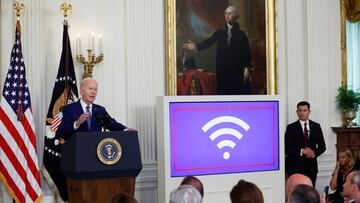Check how much your state will get in the $42.5 billion broadband infrastructure plan
The White House has announced the totals that each state will receive as a part of a new federal program to expand broadband access across the country.

Under the bipartisan infrastructure bill passed by Congress in 2021, $42.45 billion were allocated to increase access to broadband internet across the country. All states are slated to receive funding for the Broadband Equity Access and Deployment (BEAD) program.
Which states will receive the most funding?
Nearly a quarter of all funds will be sent to five states: Texas ($3.3 billion), California ($1.8 billion), Missouri ($1.7 billion), Michigan ($1.5 billion), North Carolina ($1.5 billion), and Virginia ($1.4 billion).
The state of Texas is receiving almost twice the amount of funding compared to the next closest state. The massive investment being made in Texas reflects the need to increase access to the eleven percent of households who remain unconnected.
In contrast, the percentage of households without internet access in California is slightly lower at eight percent.
As a percentage, the figures on household connectivity in Missouri (11 percent), Michigan (12 percent), North Carolina (12 percent), and Virginia (10 percent) reflect a similar situation to that seen in Texas. However, since the population of these states is smaller, the issue affects a much smaller pool of residents.
Which states will receive the least funding?
The three US territories and the District of Colombia will receive the smallest amounts in BEAD funding.
| Territory | Funding |
| U.S. Virgin Islands | $27,103,240.86 |
| American Samoa | $37,564,827.53 |
| Northern Mariana Islands | $80,796,709.02 |
| District of Columbia | $100,694,786.93 |
| Source: Internet for All | |
Now turning to the states, the smallest checks will be sent to: Massachusetts ($147 million), Connecticut ($144 billion), North Dakota ($130 million), Rhode Island ($108 million), and Delaware ($107 million). Aside from North Dakota, where twelve percent of households lack access to the internet, the figure in the four other states is under ten percent, with the median being nine percent.
The complete list...
All states will receive at least $107 million, with the White House comparing the investments made to FDR’s Rural Electrification Act which “brought electricity to nearly every home and farm in America.”
BEAD Program Funding for Each State and US Territory (Largest to Smallest)
- Texas: $3,312,616,455.45
- California: $1,864,136,508.93
- Missouri: $1,736,302,708.39
- Michigan: $1,559,362,479.29
- North Carolina: $1,532,999,481.15
- Virginia: $1,481,489,572.87
- Alabama: $1,401,221,901.77
- Louisiana: $1,355,554,552.94
- Georgia: $1,307,214,371.30
- Washington: $1,227,742,066.30
- West Virginia: $1,210,800,969.85
- Mississippi: $1,203,561,563.05
- Florida: $1,169,947,392.70
- Pennsylvania: $1,161,778,272.41
- Kentucky: $1,086,172,536.86
- Wisconsin: $1,055,823,573.71
- Illinois: $1,040,420,751.50
- Arkansas: $1,024,303,993.86
- Alaska: $1,017,139,672.42
- Arizona: $993,112,231.37
- Indiana: $868,109,929.79
- Colorado: $826,522,650.41
- Tennessee: $813,319,680.22
- Oklahoma: $797,435,691.25
- Ohio: $793,688,107.63
- Oregon: $688,914,932.17
- New Mexico: $675,372,311.86
- New York: $664,618,251.49
- Minnesota: $651,839,368.20
- Montana: $628,973,798.59
- Idaho: $583,256,249.88
- South Carolina:$551,535,983.05
- Kansas: $451,725,998.15
- Nevada: $416,666,229.74
- Iowa: $415,331,313.00
- Nebraska: $405,281,070.41
- Wyoming: $347,877,921.27
- Puerto Rico: $334,614,151.70
- Utah: $317,399,741.54
- Maine: $271,977,723.07
- Maryland: $267,738,400.71
- New Jersey: $263,689,548.65
- Vermont: $228,913,019.08
- South Dakota: $207,227,523.92
- New Hampshire: $196,560,278.97
- Guam: $156,831,733.59
- Hawaii: $149,484,493.57
- Massachusetts: $147,422,464.39
- Connecticut: $144,180,792.71
- North Dakota: $130,162,815.12
- Rhode Island: $108,718,820.75
- Delaware: $107,748,384.66
- District of Columbia: $100,694,786.93
- Northern Mariana Islands: $80,796,709.02
- American Samoa: $37,564,827.53
- U.S. Virgin Islands: $27,103,240.86
The White House hopes that these funds will get the country closer to the goal of universal internet connectivity by 2030. Currently, there are still 8.5 million households that lack access to the internet entirely or live in areas where the connection is unreliable.






